MG412 Principles of Marketing: PS5 vs Nintendo Switch Marketing Mix
VerifiedAdded on 2023/06/18
|13
|2326
|178
Report
AI Summary
This report provides a comparative analysis of the marketing mix strategies employed by PlayStation 5 and Nintendo Switch, utilizing STP analysis to understand their segmentation, targeting, and positioning approaches. It examines key elements of the marketing mix, including product/brand (applying Levitt's model and Aaker's brand personality framework), pricing strategies (competitive vs. value-based), promotional activities, and distribution channels. The report concludes that while both brands leverage the marketing mix, PlayStation has done so more effectively. It recommends that both brands focus on improving their promotional strategies to enhance brand awareness and reach a broader potential customer base. The analysis considers market share, sales trends, and the competitive landscape to provide insights into how each brand can optimize its marketing efforts.
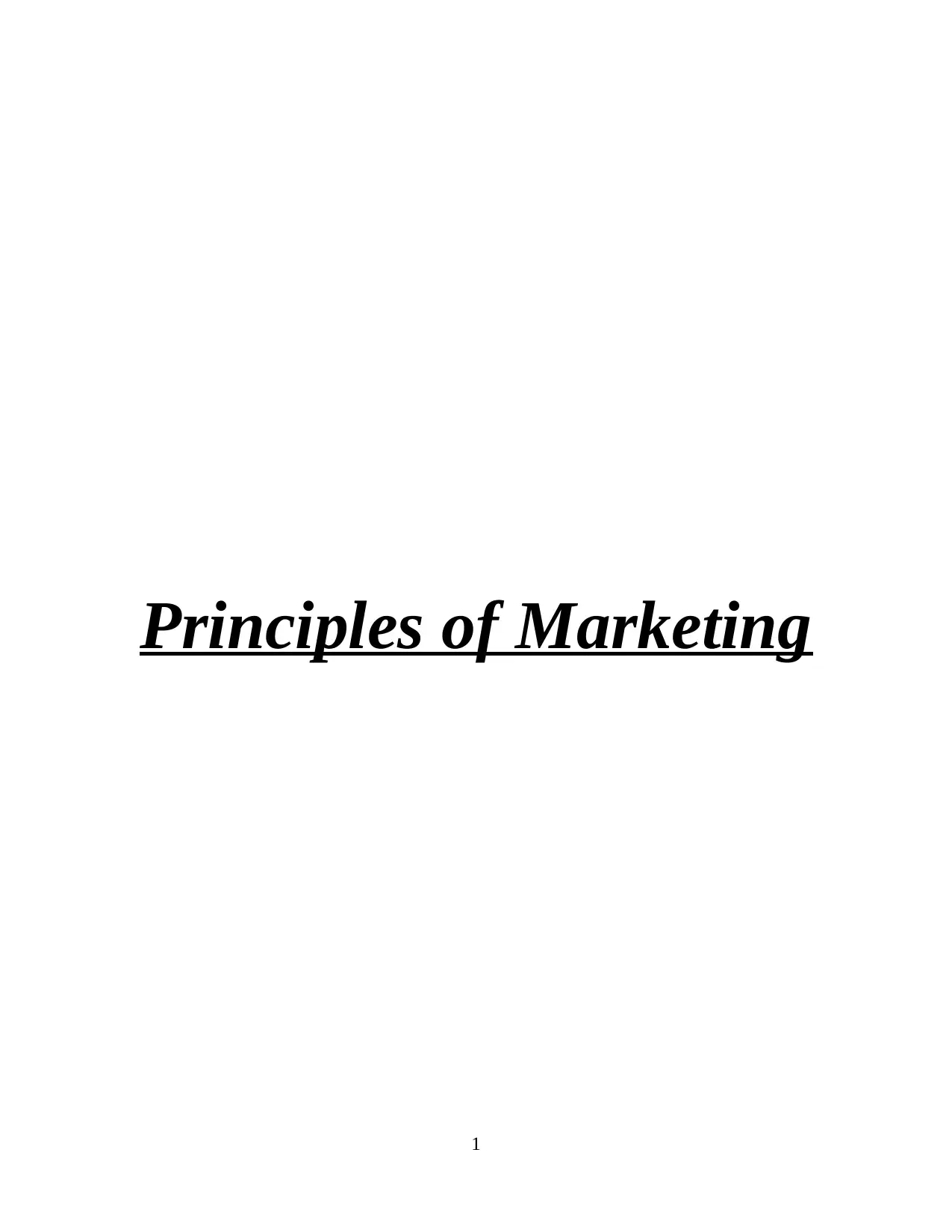
Principles of Marketing
1
1
Paraphrase This Document
Need a fresh take? Get an instant paraphrase of this document with our AI Paraphraser
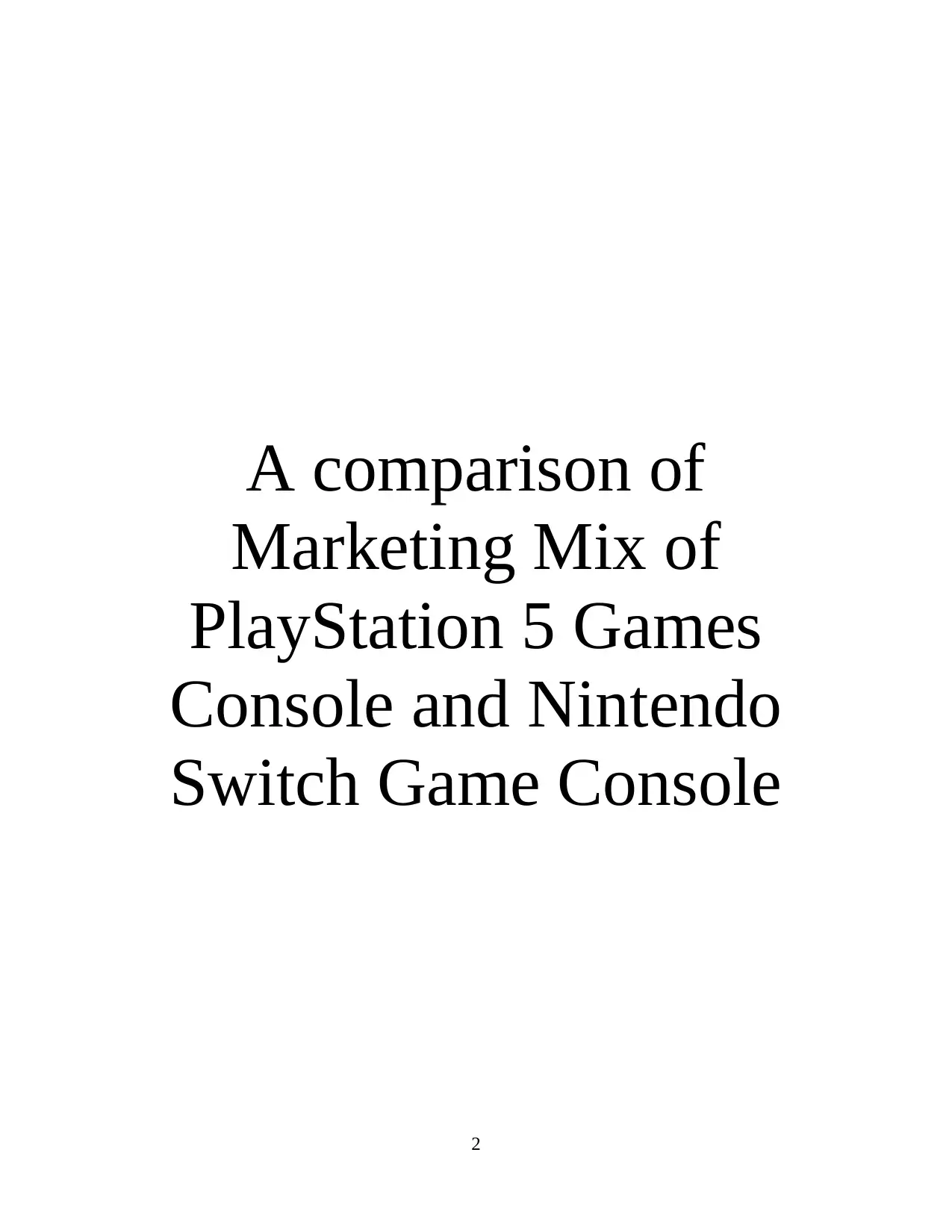
A comparison of
Marketing Mix of
PlayStation 5 Games
Console and Nintendo
Switch Game Console
2
Marketing Mix of
PlayStation 5 Games
Console and Nintendo
Switch Game Console
2
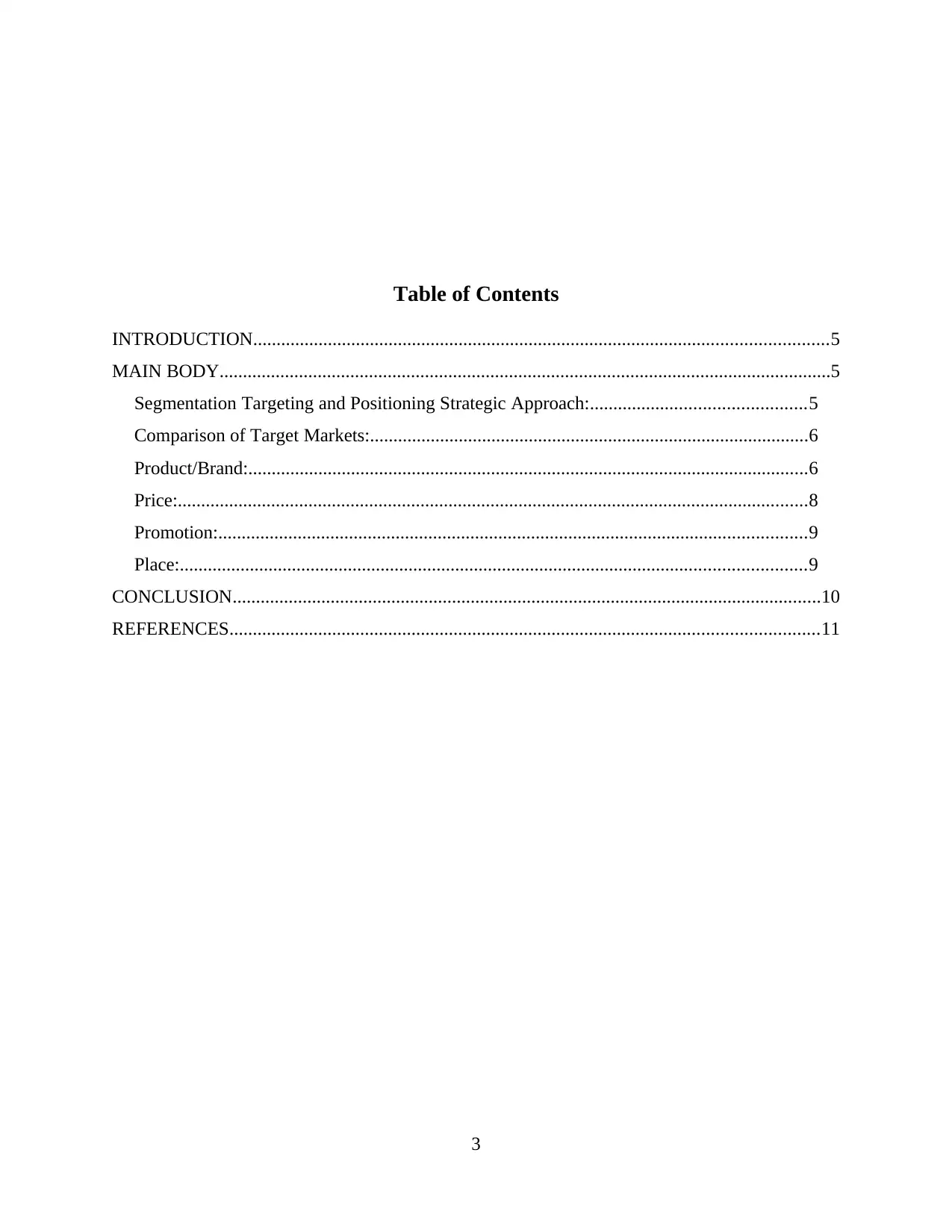
Table of Contents
INTRODUCTION...........................................................................................................................5
MAIN BODY...................................................................................................................................5
Segmentation Targeting and Positioning Strategic Approach:..............................................5
Comparison of Target Markets:..............................................................................................6
Product/Brand:........................................................................................................................6
Price:.......................................................................................................................................8
Promotion:..............................................................................................................................9
Place:......................................................................................................................................9
CONCLUSION..............................................................................................................................10
REFERENCES..............................................................................................................................11
3
INTRODUCTION...........................................................................................................................5
MAIN BODY...................................................................................................................................5
Segmentation Targeting and Positioning Strategic Approach:..............................................5
Comparison of Target Markets:..............................................................................................6
Product/Brand:........................................................................................................................6
Price:.......................................................................................................................................8
Promotion:..............................................................................................................................9
Place:......................................................................................................................................9
CONCLUSION..............................................................................................................................10
REFERENCES..............................................................................................................................11
3
⊘ This is a preview!⊘
Do you want full access?
Subscribe today to unlock all pages.

Trusted by 1+ million students worldwide
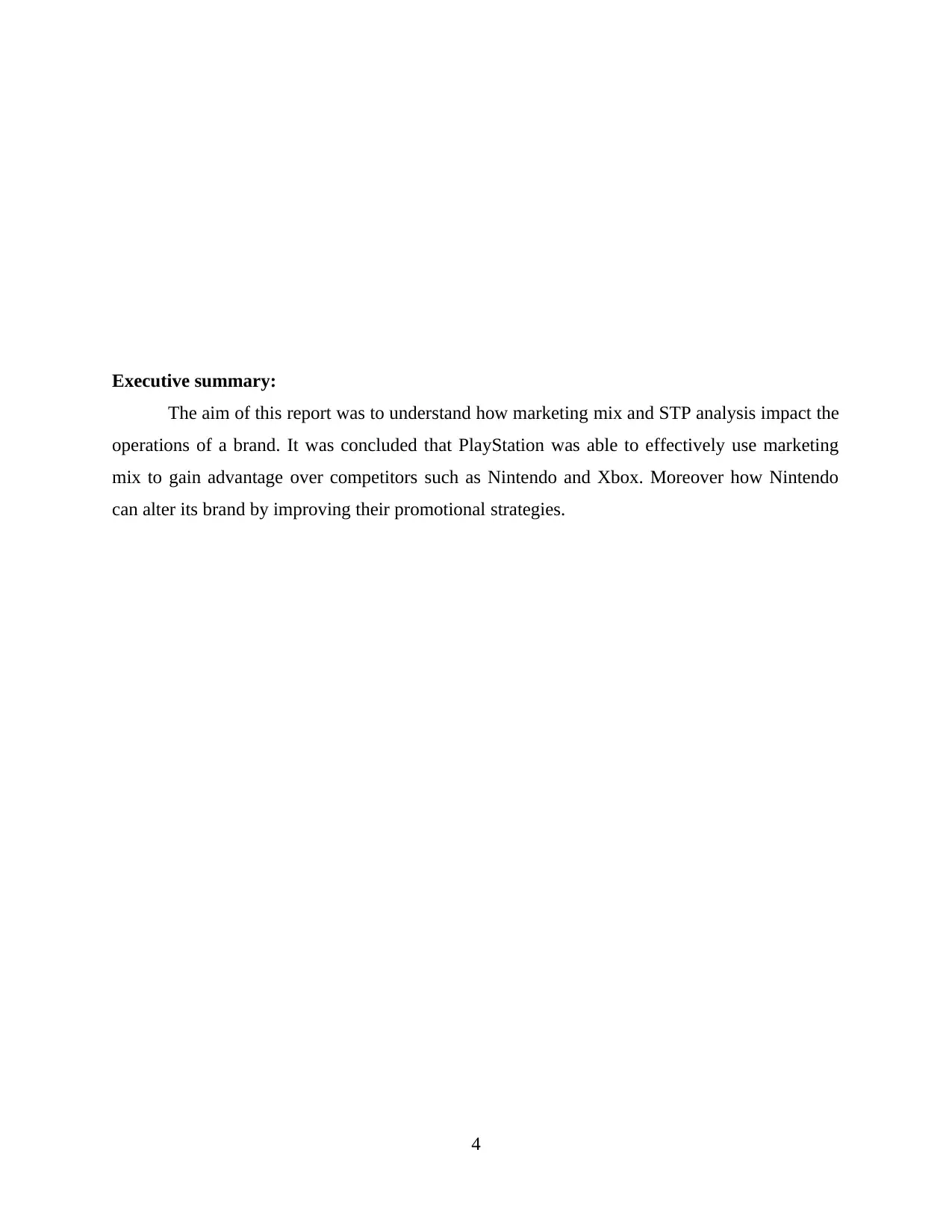
Executive summary:
The aim of this report was to understand how marketing mix and STP analysis impact the
operations of a brand. It was concluded that PlayStation was able to effectively use marketing
mix to gain advantage over competitors such as Nintendo and Xbox. Moreover how Nintendo
can alter its brand by improving their promotional strategies.
4
The aim of this report was to understand how marketing mix and STP analysis impact the
operations of a brand. It was concluded that PlayStation was able to effectively use marketing
mix to gain advantage over competitors such as Nintendo and Xbox. Moreover how Nintendo
can alter its brand by improving their promotional strategies.
4
Paraphrase This Document
Need a fresh take? Get an instant paraphrase of this document with our AI Paraphraser
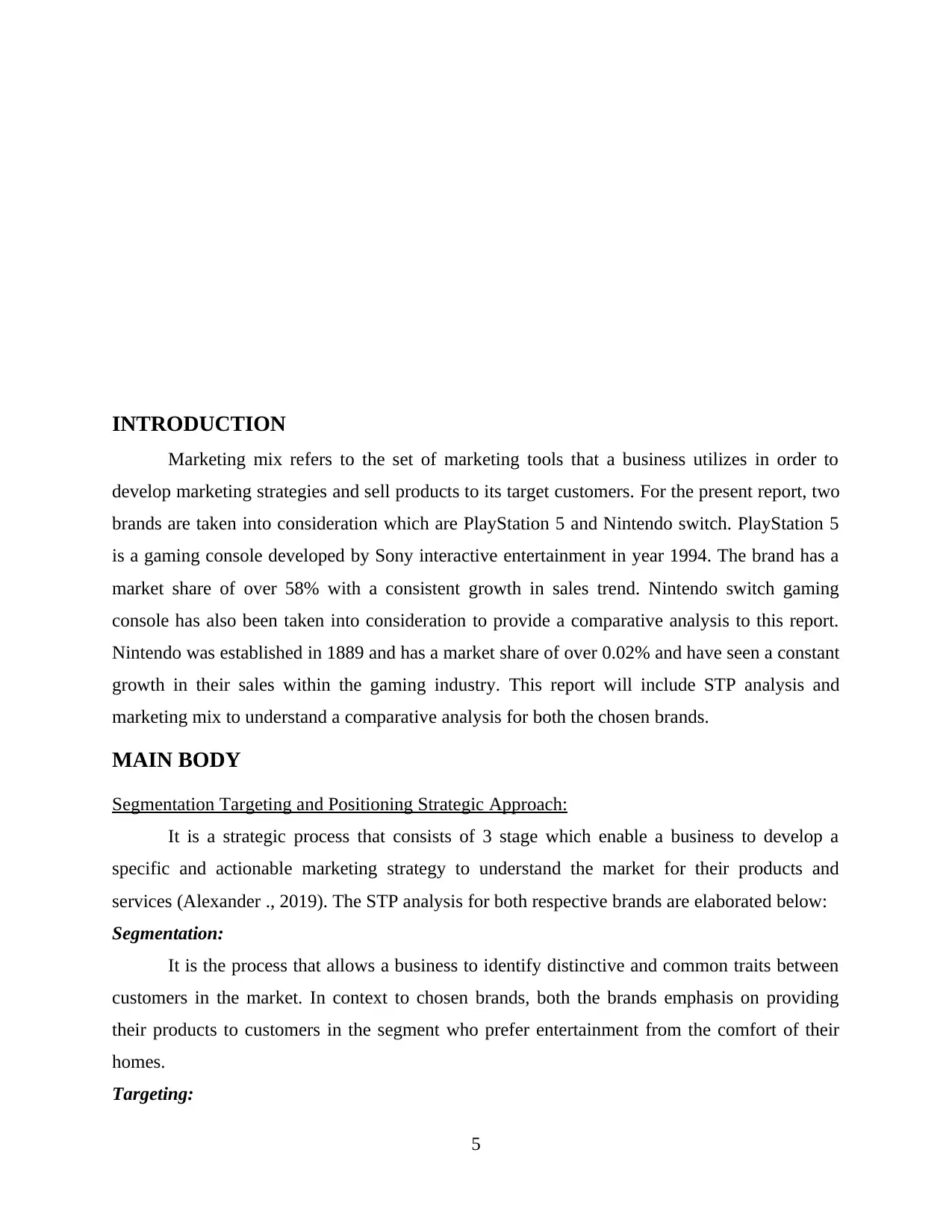
INTRODUCTION
Marketing mix refers to the set of marketing tools that a business utilizes in order to
develop marketing strategies and sell products to its target customers. For the present report, two
brands are taken into consideration which are PlayStation 5 and Nintendo switch. PlayStation 5
is a gaming console developed by Sony interactive entertainment in year 1994. The brand has a
market share of over 58% with a consistent growth in sales trend. Nintendo switch gaming
console has also been taken into consideration to provide a comparative analysis to this report.
Nintendo was established in 1889 and has a market share of over 0.02% and have seen a constant
growth in their sales within the gaming industry. This report will include STP analysis and
marketing mix to understand a comparative analysis for both the chosen brands.
MAIN BODY
Segmentation Targeting and Positioning Strategic Approach:
It is a strategic process that consists of 3 stage which enable a business to develop a
specific and actionable marketing strategy to understand the market for their products and
services (Alexander ., 2019). The STP analysis for both respective brands are elaborated below:
Segmentation:
It is the process that allows a business to identify distinctive and common traits between
customers in the market. In context to chosen brands, both the brands emphasis on providing
their products to customers in the segment who prefer entertainment from the comfort of their
homes.
Targeting:
5
Marketing mix refers to the set of marketing tools that a business utilizes in order to
develop marketing strategies and sell products to its target customers. For the present report, two
brands are taken into consideration which are PlayStation 5 and Nintendo switch. PlayStation 5
is a gaming console developed by Sony interactive entertainment in year 1994. The brand has a
market share of over 58% with a consistent growth in sales trend. Nintendo switch gaming
console has also been taken into consideration to provide a comparative analysis to this report.
Nintendo was established in 1889 and has a market share of over 0.02% and have seen a constant
growth in their sales within the gaming industry. This report will include STP analysis and
marketing mix to understand a comparative analysis for both the chosen brands.
MAIN BODY
Segmentation Targeting and Positioning Strategic Approach:
It is a strategic process that consists of 3 stage which enable a business to develop a
specific and actionable marketing strategy to understand the market for their products and
services (Alexander ., 2019). The STP analysis for both respective brands are elaborated below:
Segmentation:
It is the process that allows a business to identify distinctive and common traits between
customers in the market. In context to chosen brands, both the brands emphasis on providing
their products to customers in the segment who prefer entertainment from the comfort of their
homes.
Targeting:
5
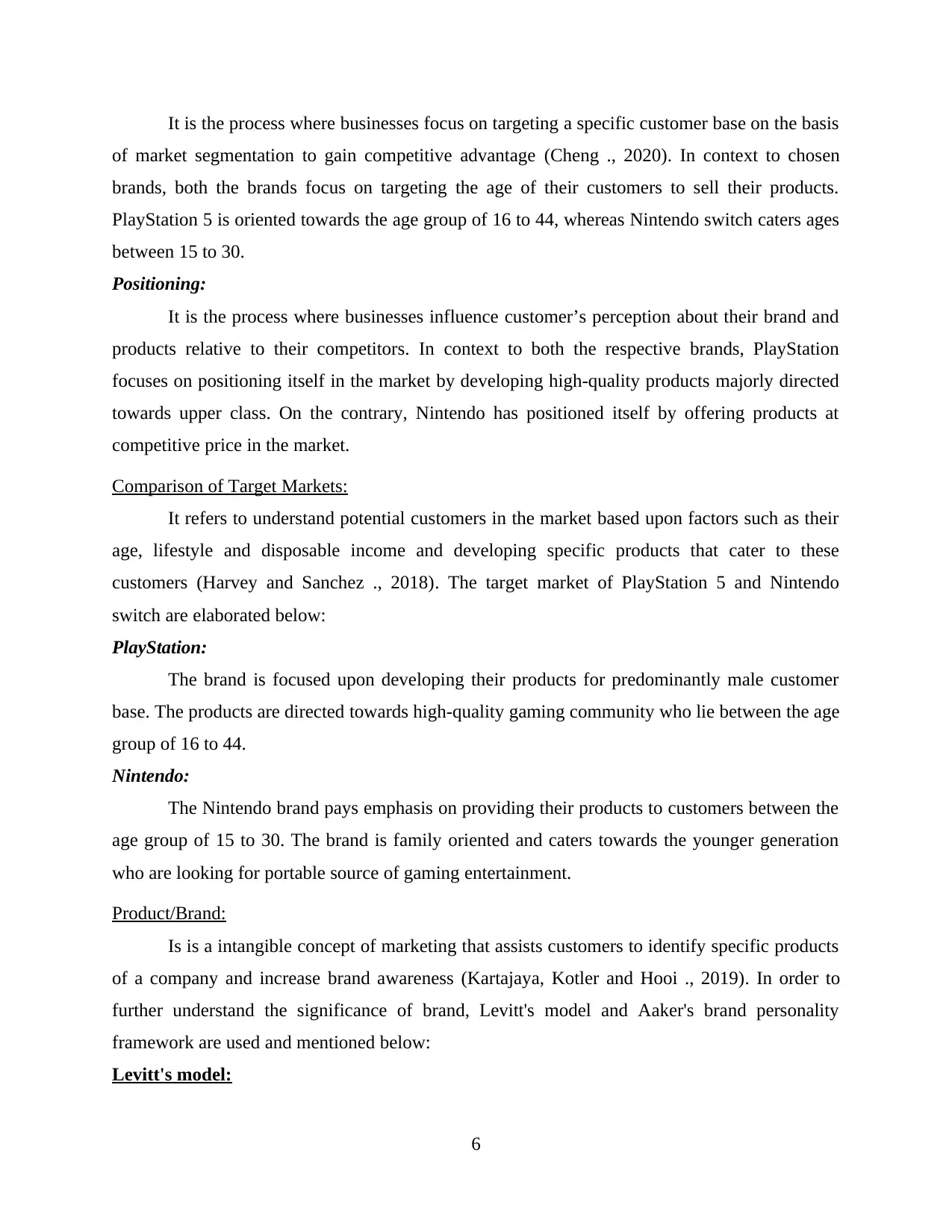
It is the process where businesses focus on targeting a specific customer base on the basis
of market segmentation to gain competitive advantage (Cheng ., 2020). In context to chosen
brands, both the brands focus on targeting the age of their customers to sell their products.
PlayStation 5 is oriented towards the age group of 16 to 44, whereas Nintendo switch caters ages
between 15 to 30.
Positioning:
It is the process where businesses influence customer’s perception about their brand and
products relative to their competitors. In context to both the respective brands, PlayStation
focuses on positioning itself in the market by developing high-quality products majorly directed
towards upper class. On the contrary, Nintendo has positioned itself by offering products at
competitive price in the market.
Comparison of Target Markets:
It refers to understand potential customers in the market based upon factors such as their
age, lifestyle and disposable income and developing specific products that cater to these
customers (Harvey and Sanchez ., 2018). The target market of PlayStation 5 and Nintendo
switch are elaborated below:
PlayStation:
The brand is focused upon developing their products for predominantly male customer
base. The products are directed towards high-quality gaming community who lie between the age
group of 16 to 44.
Nintendo:
The Nintendo brand pays emphasis on providing their products to customers between the
age group of 15 to 30. The brand is family oriented and caters towards the younger generation
who are looking for portable source of gaming entertainment.
Product/Brand:
Is is a intangible concept of marketing that assists customers to identify specific products
of a company and increase brand awareness (Kartajaya, Kotler and Hooi ., 2019). In order to
further understand the significance of brand, Levitt's model and Aaker's brand personality
framework are used and mentioned below:
Levitt's model:
6
of market segmentation to gain competitive advantage (Cheng ., 2020). In context to chosen
brands, both the brands focus on targeting the age of their customers to sell their products.
PlayStation 5 is oriented towards the age group of 16 to 44, whereas Nintendo switch caters ages
between 15 to 30.
Positioning:
It is the process where businesses influence customer’s perception about their brand and
products relative to their competitors. In context to both the respective brands, PlayStation
focuses on positioning itself in the market by developing high-quality products majorly directed
towards upper class. On the contrary, Nintendo has positioned itself by offering products at
competitive price in the market.
Comparison of Target Markets:
It refers to understand potential customers in the market based upon factors such as their
age, lifestyle and disposable income and developing specific products that cater to these
customers (Harvey and Sanchez ., 2018). The target market of PlayStation 5 and Nintendo
switch are elaborated below:
PlayStation:
The brand is focused upon developing their products for predominantly male customer
base. The products are directed towards high-quality gaming community who lie between the age
group of 16 to 44.
Nintendo:
The Nintendo brand pays emphasis on providing their products to customers between the
age group of 15 to 30. The brand is family oriented and caters towards the younger generation
who are looking for portable source of gaming entertainment.
Product/Brand:
Is is a intangible concept of marketing that assists customers to identify specific products
of a company and increase brand awareness (Kartajaya, Kotler and Hooi ., 2019). In order to
further understand the significance of brand, Levitt's model and Aaker's brand personality
framework are used and mentioned below:
Levitt's model:
6
⊘ This is a preview!⊘
Do you want full access?
Subscribe today to unlock all pages.

Trusted by 1+ million students worldwide
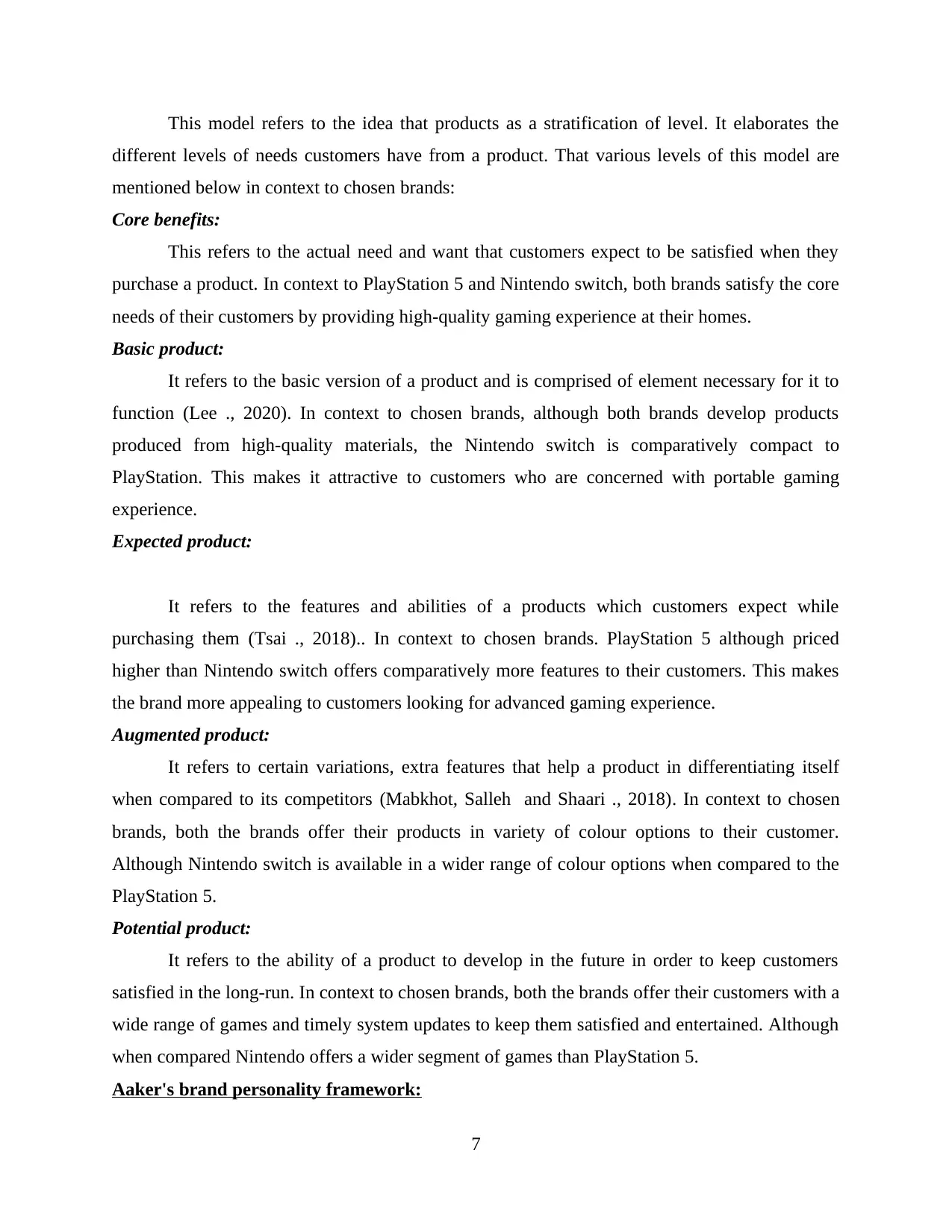
This model refers to the idea that products as a stratification of level. It elaborates the
different levels of needs customers have from a product. That various levels of this model are
mentioned below in context to chosen brands:
Core benefits:
This refers to the actual need and want that customers expect to be satisfied when they
purchase a product. In context to PlayStation 5 and Nintendo switch, both brands satisfy the core
needs of their customers by providing high-quality gaming experience at their homes.
Basic product:
It refers to the basic version of a product and is comprised of element necessary for it to
function (Lee ., 2020). In context to chosen brands, although both brands develop products
produced from high-quality materials, the Nintendo switch is comparatively compact to
PlayStation. This makes it attractive to customers who are concerned with portable gaming
experience.
Expected product:
It refers to the features and abilities of a products which customers expect while
purchasing them (Tsai ., 2018).. In context to chosen brands. PlayStation 5 although priced
higher than Nintendo switch offers comparatively more features to their customers. This makes
the brand more appealing to customers looking for advanced gaming experience.
Augmented product:
It refers to certain variations, extra features that help a product in differentiating itself
when compared to its competitors (Mabkhot, Salleh and Shaari ., 2018). In context to chosen
brands, both the brands offer their products in variety of colour options to their customer.
Although Nintendo switch is available in a wider range of colour options when compared to the
PlayStation 5.
Potential product:
It refers to the ability of a product to develop in the future in order to keep customers
satisfied in the long-run. In context to chosen brands, both the brands offer their customers with a
wide range of games and timely system updates to keep them satisfied and entertained. Although
when compared Nintendo offers a wider segment of games than PlayStation 5.
Aaker's brand personality framework:
7
different levels of needs customers have from a product. That various levels of this model are
mentioned below in context to chosen brands:
Core benefits:
This refers to the actual need and want that customers expect to be satisfied when they
purchase a product. In context to PlayStation 5 and Nintendo switch, both brands satisfy the core
needs of their customers by providing high-quality gaming experience at their homes.
Basic product:
It refers to the basic version of a product and is comprised of element necessary for it to
function (Lee ., 2020). In context to chosen brands, although both brands develop products
produced from high-quality materials, the Nintendo switch is comparatively compact to
PlayStation. This makes it attractive to customers who are concerned with portable gaming
experience.
Expected product:
It refers to the features and abilities of a products which customers expect while
purchasing them (Tsai ., 2018).. In context to chosen brands. PlayStation 5 although priced
higher than Nintendo switch offers comparatively more features to their customers. This makes
the brand more appealing to customers looking for advanced gaming experience.
Augmented product:
It refers to certain variations, extra features that help a product in differentiating itself
when compared to its competitors (Mabkhot, Salleh and Shaari ., 2018). In context to chosen
brands, both the brands offer their products in variety of colour options to their customer.
Although Nintendo switch is available in a wider range of colour options when compared to the
PlayStation 5.
Potential product:
It refers to the ability of a product to develop in the future in order to keep customers
satisfied in the long-run. In context to chosen brands, both the brands offer their customers with a
wide range of games and timely system updates to keep them satisfied and entertained. Although
when compared Nintendo offers a wider segment of games than PlayStation 5.
Aaker's brand personality framework:
7
Paraphrase This Document
Need a fresh take? Get an instant paraphrase of this document with our AI Paraphraser
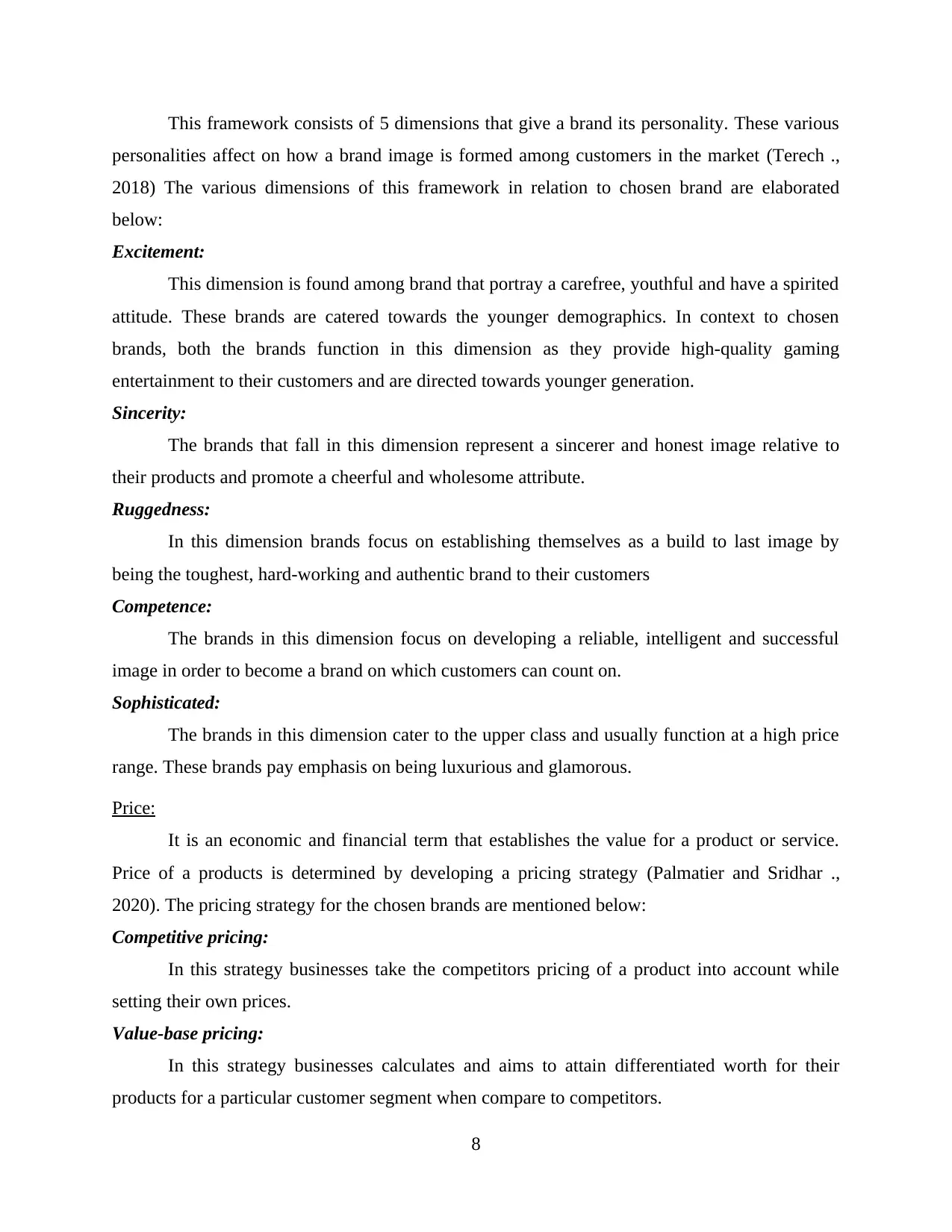
This framework consists of 5 dimensions that give a brand its personality. These various
personalities affect on how a brand image is formed among customers in the market (Terech .,
2018) The various dimensions of this framework in relation to chosen brand are elaborated
below:
Excitement:
This dimension is found among brand that portray a carefree, youthful and have a spirited
attitude. These brands are catered towards the younger demographics. In context to chosen
brands, both the brands function in this dimension as they provide high-quality gaming
entertainment to their customers and are directed towards younger generation.
Sincerity:
The brands that fall in this dimension represent a sincerer and honest image relative to
their products and promote a cheerful and wholesome attribute.
Ruggedness:
In this dimension brands focus on establishing themselves as a build to last image by
being the toughest, hard-working and authentic brand to their customers
Competence:
The brands in this dimension focus on developing a reliable, intelligent and successful
image in order to become a brand on which customers can count on.
Sophisticated:
The brands in this dimension cater to the upper class and usually function at a high price
range. These brands pay emphasis on being luxurious and glamorous.
Price:
It is an economic and financial term that establishes the value for a product or service.
Price of a products is determined by developing a pricing strategy (Palmatier and Sridhar .,
2020). The pricing strategy for the chosen brands are mentioned below:
Competitive pricing:
In this strategy businesses take the competitors pricing of a product into account while
setting their own prices.
Value-base pricing:
In this strategy businesses calculates and aims to attain differentiated worth for their
products for a particular customer segment when compare to competitors.
8
personalities affect on how a brand image is formed among customers in the market (Terech .,
2018) The various dimensions of this framework in relation to chosen brand are elaborated
below:
Excitement:
This dimension is found among brand that portray a carefree, youthful and have a spirited
attitude. These brands are catered towards the younger demographics. In context to chosen
brands, both the brands function in this dimension as they provide high-quality gaming
entertainment to their customers and are directed towards younger generation.
Sincerity:
The brands that fall in this dimension represent a sincerer and honest image relative to
their products and promote a cheerful and wholesome attribute.
Ruggedness:
In this dimension brands focus on establishing themselves as a build to last image by
being the toughest, hard-working and authentic brand to their customers
Competence:
The brands in this dimension focus on developing a reliable, intelligent and successful
image in order to become a brand on which customers can count on.
Sophisticated:
The brands in this dimension cater to the upper class and usually function at a high price
range. These brands pay emphasis on being luxurious and glamorous.
Price:
It is an economic and financial term that establishes the value for a product or service.
Price of a products is determined by developing a pricing strategy (Palmatier and Sridhar .,
2020). The pricing strategy for the chosen brands are mentioned below:
Competitive pricing:
In this strategy businesses take the competitors pricing of a product into account while
setting their own prices.
Value-base pricing:
In this strategy businesses calculates and aims to attain differentiated worth for their
products for a particular customer segment when compare to competitors.
8

Cost-plus pricing:
In this strategy businesses add a markup to their products original unit cost to determine
the final selling price.
PlayStation:
Brand Product Online price Offline price
PlayStation PlayStation 5 £449 £449
Xbox Series X £449 £449
The brand uses competitive pricing strategy in order to compete with their competitors in
the market and use their strength of popularity to gain customers.
Nintendo:
Brand Product Online price Offline price
Nintendo Nintendo switch £259 £269
GDP GDP XD plus £199 £199
The brand uses value-base pricing to gain a competitive advantage in the market due to
its well established reputation and track record of reliability.
Promotion:
It is a method by which businesses promote their products to potential customers and try
to differentiate their products from the competitors by utilizing advertising and promotional
strategies (Shaari et. al., 2019.). The promotion methods of chosen brands are mentioned below:
PlayStation:
The brand had previously used TV advertisements and print media to promote their
products. It now utilizes social media, billboards and various internet services to promote their
products and attract customers by advertising their products as a essential product for home
entertainment.
Nintendo:
9
In this strategy businesses add a markup to their products original unit cost to determine
the final selling price.
PlayStation:
Brand Product Online price Offline price
PlayStation PlayStation 5 £449 £449
Xbox Series X £449 £449
The brand uses competitive pricing strategy in order to compete with their competitors in
the market and use their strength of popularity to gain customers.
Nintendo:
Brand Product Online price Offline price
Nintendo Nintendo switch £259 £269
GDP GDP XD plus £199 £199
The brand uses value-base pricing to gain a competitive advantage in the market due to
its well established reputation and track record of reliability.
Promotion:
It is a method by which businesses promote their products to potential customers and try
to differentiate their products from the competitors by utilizing advertising and promotional
strategies (Shaari et. al., 2019.). The promotion methods of chosen brands are mentioned below:
PlayStation:
The brand had previously used TV advertisements and print media to promote their
products. It now utilizes social media, billboards and various internet services to promote their
products and attract customers by advertising their products as a essential product for home
entertainment.
Nintendo:
9
⊘ This is a preview!⊘
Do you want full access?
Subscribe today to unlock all pages.

Trusted by 1+ million students worldwide
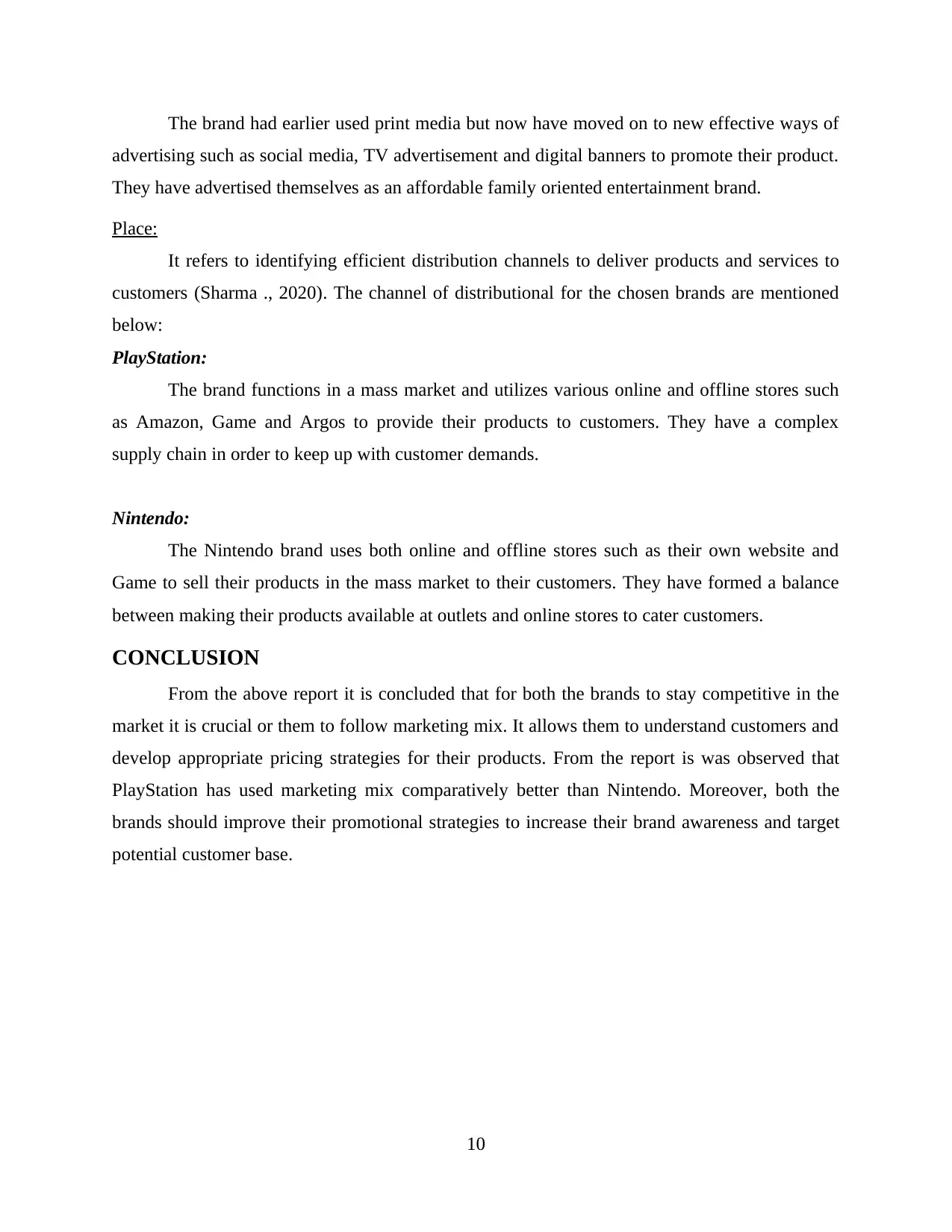
The brand had earlier used print media but now have moved on to new effective ways of
advertising such as social media, TV advertisement and digital banners to promote their product.
They have advertised themselves as an affordable family oriented entertainment brand.
Place:
It refers to identifying efficient distribution channels to deliver products and services to
customers (Sharma ., 2020). The channel of distributional for the chosen brands are mentioned
below:
PlayStation:
The brand functions in a mass market and utilizes various online and offline stores such
as Amazon, Game and Argos to provide their products to customers. They have a complex
supply chain in order to keep up with customer demands.
Nintendo:
The Nintendo brand uses both online and offline stores such as their own website and
Game to sell their products in the mass market to their customers. They have formed a balance
between making their products available at outlets and online stores to cater customers.
CONCLUSION
From the above report it is concluded that for both the brands to stay competitive in the
market it is crucial or them to follow marketing mix. It allows them to understand customers and
develop appropriate pricing strategies for their products. From the report is was observed that
PlayStation has used marketing mix comparatively better than Nintendo. Moreover, both the
brands should improve their promotional strategies to increase their brand awareness and target
potential customer base.
10
advertising such as social media, TV advertisement and digital banners to promote their product.
They have advertised themselves as an affordable family oriented entertainment brand.
Place:
It refers to identifying efficient distribution channels to deliver products and services to
customers (Sharma ., 2020). The channel of distributional for the chosen brands are mentioned
below:
PlayStation:
The brand functions in a mass market and utilizes various online and offline stores such
as Amazon, Game and Argos to provide their products to customers. They have a complex
supply chain in order to keep up with customer demands.
Nintendo:
The Nintendo brand uses both online and offline stores such as their own website and
Game to sell their products in the mass market to their customers. They have formed a balance
between making their products available at outlets and online stores to cater customers.
CONCLUSION
From the above report it is concluded that for both the brands to stay competitive in the
market it is crucial or them to follow marketing mix. It allows them to understand customers and
develop appropriate pricing strategies for their products. From the report is was observed that
PlayStation has used marketing mix comparatively better than Nintendo. Moreover, both the
brands should improve their promotional strategies to increase their brand awareness and target
potential customer base.
10
Paraphrase This Document
Need a fresh take? Get an instant paraphrase of this document with our AI Paraphraser
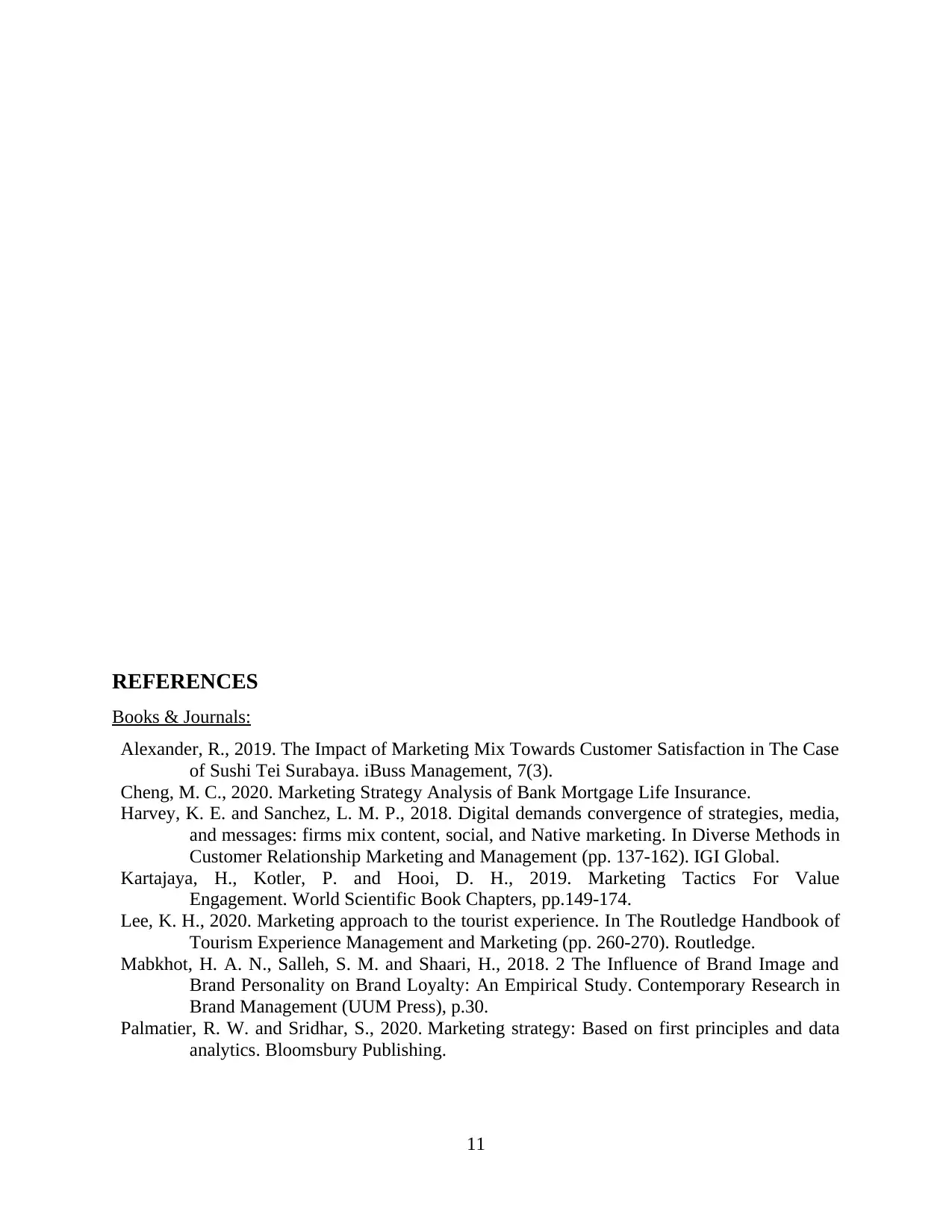
REFERENCES
Books & Journals:
Alexander, R., 2019. The Impact of Marketing Mix Towards Customer Satisfaction in The Case
of Sushi Tei Surabaya. iBuss Management, 7(3).
Cheng, M. C., 2020. Marketing Strategy Analysis of Bank Mortgage Life Insurance.
Harvey, K. E. and Sanchez, L. M. P., 2018. Digital demands convergence of strategies, media,
and messages: firms mix content, social, and Native marketing. In Diverse Methods in
Customer Relationship Marketing and Management (pp. 137-162). IGI Global.
Kartajaya, H., Kotler, P. and Hooi, D. H., 2019. Marketing Tactics For Value
Engagement. World Scientific Book Chapters, pp.149-174.
Lee, K. H., 2020. Marketing approach to the tourist experience. In The Routledge Handbook of
Tourism Experience Management and Marketing (pp. 260-270). Routledge.
Mabkhot, H. A. N., Salleh, S. M. and Shaari, H., 2018. 2 The Influence of Brand Image and
Brand Personality on Brand Loyalty: An Empirical Study. Contemporary Research in
Brand Management (UUM Press), p.30.
Palmatier, R. W. and Sridhar, S., 2020. Marketing strategy: Based on first principles and data
analytics. Bloomsbury Publishing.
11
Books & Journals:
Alexander, R., 2019. The Impact of Marketing Mix Towards Customer Satisfaction in The Case
of Sushi Tei Surabaya. iBuss Management, 7(3).
Cheng, M. C., 2020. Marketing Strategy Analysis of Bank Mortgage Life Insurance.
Harvey, K. E. and Sanchez, L. M. P., 2018. Digital demands convergence of strategies, media,
and messages: firms mix content, social, and Native marketing. In Diverse Methods in
Customer Relationship Marketing and Management (pp. 137-162). IGI Global.
Kartajaya, H., Kotler, P. and Hooi, D. H., 2019. Marketing Tactics For Value
Engagement. World Scientific Book Chapters, pp.149-174.
Lee, K. H., 2020. Marketing approach to the tourist experience. In The Routledge Handbook of
Tourism Experience Management and Marketing (pp. 260-270). Routledge.
Mabkhot, H. A. N., Salleh, S. M. and Shaari, H., 2018. 2 The Influence of Brand Image and
Brand Personality on Brand Loyalty: An Empirical Study. Contemporary Research in
Brand Management (UUM Press), p.30.
Palmatier, R. W. and Sridhar, S., 2020. Marketing strategy: Based on first principles and data
analytics. Bloomsbury Publishing.
11

Shaari et. al., 2019. Assessing the effect of university brand personality and attitude towards
donation on alumni donor behavioural intention: Malaysian perspective. International
Journal of Management in Education, 13(4). pp.377-396.
Sharma, R., 2020. Building Consumer-based Brand Equity for Fast Fashion Apparel Brands in
the Indian Consumer Market. Management and Labour Studies, 45(3). pp.337-365.
Terech, A., 2018. An introduction to marketing and branding. Generations, 42(1). pp.45-49.
Tsai, Y. M., 2018. A Study of Management and Development Strategies of a Dermatology
Clinic.
(Alexander ., 2019)(Cheng ., 2020)(Harvey and Sanchez ., 2018)(Kartajaya, Kotler and Hooi .,
2019)(Lee ., 2020)(Mabkhot, Salleh and Shaari ., 2018)(Palmatier and Sridhar .,
2020)(Shaari et. al., 2019.)(Sharma ., 2020)(Terech ., 2018)(Tsai ., 2018)
12
donation on alumni donor behavioural intention: Malaysian perspective. International
Journal of Management in Education, 13(4). pp.377-396.
Sharma, R., 2020. Building Consumer-based Brand Equity for Fast Fashion Apparel Brands in
the Indian Consumer Market. Management and Labour Studies, 45(3). pp.337-365.
Terech, A., 2018. An introduction to marketing and branding. Generations, 42(1). pp.45-49.
Tsai, Y. M., 2018. A Study of Management and Development Strategies of a Dermatology
Clinic.
(Alexander ., 2019)(Cheng ., 2020)(Harvey and Sanchez ., 2018)(Kartajaya, Kotler and Hooi .,
2019)(Lee ., 2020)(Mabkhot, Salleh and Shaari ., 2018)(Palmatier and Sridhar .,
2020)(Shaari et. al., 2019.)(Sharma ., 2020)(Terech ., 2018)(Tsai ., 2018)
12
⊘ This is a preview!⊘
Do you want full access?
Subscribe today to unlock all pages.

Trusted by 1+ million students worldwide
1 out of 13
Related Documents
Your All-in-One AI-Powered Toolkit for Academic Success.
+13062052269
info@desklib.com
Available 24*7 on WhatsApp / Email
![[object Object]](/_next/static/media/star-bottom.7253800d.svg)
Unlock your academic potential
Copyright © 2020–2025 A2Z Services. All Rights Reserved. Developed and managed by ZUCOL.





